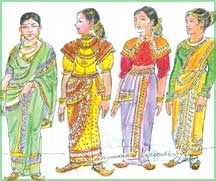
by PADMA EDIRISINGHE
Sunday Observer April 27 2003
It cost the polygamous Henry VIIIth of England a gigantic endeavour of ripping away his country from the iron hand of the Papal rule of the Vatican, to bed with six wives. But as if to demonstrate the unpredictability of this strange universe, the East, flaunting conservatism and a religious and moral veneer had kings who kept whole harems to satiate their erotic desires.
Stranger still literary works were produced in abundance gloating in lush detail on the Bacchchalian merrymaking of these monarchs with their umpteen spouses endowed with much beauty, (Our own Kavsilumina is one such example).

Of course our antha-puras could not compete with the exotic harems of the Sheiks's desert kingdoms, yet that our kings had many a lesser queen later demoted to concubines is a well-known fact.
However polygamy seems to have been the prerogative of the king and the feudal lords whose nindagam turned into chena-lands of kept females, if the lords were so inclined. The average society seems to have followed the one man, one woman rule, though then, as now, there was a siy violation of this rule.
However even in the highlands where accepted moral standards with regard to sexual behaviour seem to have been more lax (excuse me), there seems to have been serious punishments for female infidelity in the 17th Century when the famous Robert Knox wandered about collecting social data. He writes, "It is a law here (in Lanka) that if a man catches another in bed with his wife, ... whatsoever, kill him and her if he pleases".
Though much intolerance has been made to faithless wives no such horrible specific punishment for such errant husbands is mentioned in his book. That is female discrimination in ancient and medieval times going on to the present.
A peculiar case of discrimination of Sinhala women surfaces with regard to the concubines of our later kings.
Our rulers beginning from the first king imported queens from South India. The most vicious case of female discrimination was staged during the first king Vijaya's time when he banished a woman of an indigenous tribe who helped him to conquer the island, just to make way for a princess of royal lineage imported from the sub-continent.
Though this wife-import was continued by later kings too. Eventually the practice ceased with the springing of royal houses here to provide consorts for kings. But again during Rajasinghes time the practice was resumed probably due to the drying up of the Royal families who provided princesses J. Dias Abeysinghe mentions one such Keerawella family of royal blood that became extinct.
According to the Chulavamsa Rajasinghe 11 imported a princess from Madurai in South India and the practice continued eventually even lead in to the extinction of the Sinhala royal line when a strange inheritance law of South India was dug up for the Malabar brother-in-law to take over the legacy.
A stranger practice continued when into the third category of wives was packed the Sinhala wives who were more or less kept in their own villages as concubines. The first category, The Randolis and the second category, lived in Meda and Palle Vehala.
That the Yakadadolis, the third category of concubines did not live with the king is amply testified by the fact that when the last king was captured only the Tamil speaking queens were with him. The Sinhala queens or more correctly concubines were safely in their own homes. It was the South Indian wives who hung around the neck of V. Dias, the ancestor of the Bandranaike family crying and shouting "Andavane" in distress (according to his diary).
Mr. Kapila Vimaladharma in his recent book, "Women in the Kandyan Kingdom" says that probably the Randolis were called so since they rode in gold-gilt palanquins and the Yakada - dolis were called so since they rode in iron - wrought palanquins. The Yakadadolis languished in their own villages awaiting a rare charika (tour) by the king. Yet they seem to have been well treated. Extensive land grants had been made to them and males in the families raised to Bandara status.
The worst discrimination the concubines suffered from was that their offsprings by the king were not recognized as heirs to the throne. Thus when the last Sinhala king's South Indian wives failed to produce a son a move was afoot to crown the son of Unamboowa Kumarihamy by the king but it was not successful due to the above factor plus the jealousy of other chieftains.
In an interesting article written by Mr. Wimaladharma to the RAS Journal 2000 he mentions the fountain areas from which the concubines were drawn. They are as follows:
Rambukwella and Alutgama families in Udu Dumbara.
Amunugama and Halyale families in Patha Dumbara.
Aludeniya, Mampitiya and Dunuvila families.
Harispattuwa Moonerawila family in Matale.
Unamboowa family from Udapalatha.
These concubines had also begun to be called Dugganna unnanses. It is a point of interest to note that on the British conquest of Kandy, Chandra Rekavo, a concubine of the last king (according to the same source) had been banished to Colombo. Before her departure she had made a grant of the land bequeathed to her by the king to Weragoda and Kotugodella temples.
It is a further point of interest to note that even attractive Muslim women had been kept as concubines, mostly hailing from Ukuwela village.